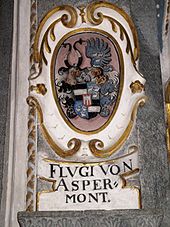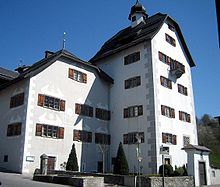Barons of Aspermont

The Lords of Aspermont were a medieval Swiss noble family.
Family history
The name Aspermont is derived from Latin and means "rough mountain". The aristocratic family appears in the documents in the 12th century and had their ancestral seat at Alt-Aspermont Castle near Trimmis and also founded Neu-Aspermont Castle above Jenins . From simple servants to the Bishop of Chur, they rose over a few generations into the circle of the most influential families in Rhaetia .
Around the middle of the 14th century the Aspermont disappeared from Raetia. Around 1350 the brothers Ulrich and Eberhard sold the castle to the knight Rudolf von Rankweil from Feldkirch. In 1376 Ulrich XI gave away. von Aspermont, probably the last of the family, the funeral right in the church of Chur to the Lords of Greifensee . He then lived in Dornbirn and translated the name Aspermont into Rhomberg . The Aspermont were members of the Ten Court Association , which was founded in what is now Graubünden on June 8, 1436.
Modern times
In Texas, the settlement Aspermont was founded in 1889 by AL Rhomberg, who gave the settlement its name and made the land available. It is uncertain whether Rhomberg has anything to do with the Aspermont gentlemen - but it is entirely conceivable.
people
- Ulrich of Aspermont
- Countess Elisabeth of Aspermont
- Johannes V. Flugi von Aspermont, (Bishop of Chur 1601–1627)
- John VI Flugi von Aspermont (Bishop of Chur 1636–1661)
The family Flugi von Aspermont is not related to the lords of Aspermont. After their extinction, the rule of Aspermont fell to the diocese of Chur. Bishop Johann VI. increased his coat of arms with that of the Lords of Aspermont and added a heart shield, which shows a church flag. At the same time he increased his name with the expired surname of Aspermont. It is unclear whether he carried out this increase in rank in his authority as prince-bishop or whether it was actually an ennoblement by Emperor Ferdinand III. von Habsburg took place. The Flugi van Aspermont family currently still lives in the Netherlands and Italy. Further offspring are not known under the name Flugi, but under Flouch.
Castles and Palaces
Fürstenburg (Castel del Principe)
The coat of arms of Prince-Bishop Johann VI. Flugi von Aspermont can still be seen in this castle complex near Burgeis .
Fracstein Castle
→ Main article: Fracstein Castle
In 1338 the cave castle in Graubünden was first mentioned as a property of the Lords of Aspermont.
Neu-Aspermont Castle
→ Main article: Neu-Aspermont Castle
Neu-Aspermont Castle is a ruined castle from the first half or mid-13th century on the right side of the valley above Jenins in the Graubünden Rhine Valley in Switzerland.
Haldenstein Castle
→ Main article: Haldenstein Castle
In 1567, the Lord of Neu-Aspermont, Captain Gregor von Hohenbalken , bought Haldenstein from Castion's successors for 3,200 guilders.
Castle ruins of Castels
The castle complex near Luzein was owned by Ulrich von Aspermont in the 14th century.
Aspermont Castle
in Sagogn
Individual evidence
- ↑ Werner Meyer - Castles of Switzerland - Volume 3: Canton of Graubünden (German-speaking and Romance parts). Zurich, 1983


